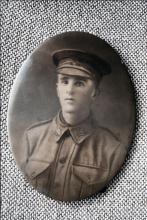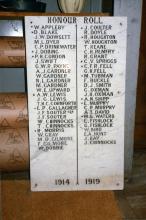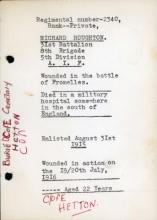Richard Houghton
Richard Houghton (Service No 2340) was born in Durham, England, in November 1893 to Andrew and Mary Lizzie. The family arrived in Australia in 1913. When Richard enlisted he and his family resided at Gray Street, Keiraville.
Richard worked as a blacksmith before the war but ultimately enlisted as did his younger brother, William. Both brothers were members of the Druids Society.
Richard served in the 31st Infantry Battalion, 8th Brigade, 5th Division:
The 31st Battalion was known to the rest of the Aussie Army as Tivvy’s chocs, the reason being that General Tivvy, as a colonel, had been the battalion commander right through until the formation of the new units in Egypt, when he was promoted Brigadier General in charge of the either Brigade.
And so the battalion was the only one in the Australian army to have a nickname, and they were proud of it.
The 8th Brigade, consisting of the 29th, 30th, 31st and 32nd battalions, which formed the left flank of the attack had, while waiting at the front line, suffered more severely than the rest of the Australian troops. The reason for this was partly that it lay on the flank, and partly that its front line, running closer to the enemy than that of the other sectors, not only received special attention from the enemy, but also caught a number of shells from its own guns intended for the enemy’s wire…
…Several hundred yards farther still could be seen barbed wire entanglements – probably those protecting a German strong-point, known as “Grashof”, then in course of construction. Toll knew that this could not possibly be the “Support Line” referred to in the operation orders, and it appeared to be a strong position. Small parties of the 14th Brigade could be seen away on the right, and Toll tried to communicate with them, and Bernard went out to obtain torch and was immediately shot – Toll then returned and found that Major Eckersley’s line was still out of touch with any troops on either flank. The sun was setting and from Delangre farm and the houses of Les Clochers village beyond there came this chatter of machine-guns. The enemy’s guns had found and were effectively shelling the unprotected troops, who were also caught by occasional shells from their own guns. The men were consequently under no small strain, and German reinforcements could be seen moving from the rear to Delangre farm…
Richard was fighting in Fromelles when he was reported missing in action on July 19, 1916 and was reported wounded in action on July 20, 1916. He was admitted to hospital at Wimereux on July 21. He was despatched to the Bevan Military Hospital, Sandgate, England, and died as a result of his wounds on August 5, 1916. He was 22 years of age.
Richard Houghton is buried at Hatton Lane Cemetery, England; a photo of his grave has been shared below.
Richard is commemorated at the Australian War Memorial, and on Keiraville Public School’s Roll of Honour.
Links
-
First World War Embarkation Roll - Richard Houghton
- http://www.awm.gov.au/people/rolls/R1970699/
-
Richard Houghton
- https://www.aif.adfa.edu.au/showPerson?pid=143977
The AIF Project
-
Richard Houghton
- https://www.awm.gov.au/people/rolls/R1631250/
Roll of Honour
-
Richard Houghton
- http://static.awm.gov.au/images/collection/pdf/RCDIG1061613--1-.pdf
Australian Red Cross Wounded and Missing
-
Richard Houghton
- http://www.cwgc.org/find-war-dead.aspx?cpage=1
Commonwealth War Graves Commission




